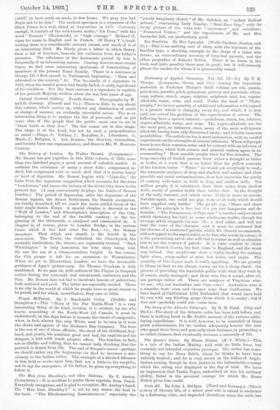The History of London. By Walter Besant. (Longmans.)- Mr. Besant
has put together in this little volume, of little more than two hundred pages, a great amount of valuable matter. It contains the substance of many a stout folio ; compressed in- deed, but compressed with so much skill that it is nowise heavy or hard of digestion. Mr. Besant begins with " Llyn-din," the Lake Fort, the ingenious suggestion which accounts for the form "Londinium," and traces the history of the Great City down to the present day. (A map conveniently displays the limits of Roman London.) The period of depression, after the departure of the Roman legions, the Saxon Settlement, the Danish occupation, are briefly described, till we reach the more settled times of the later Anglo-Saxon Kings. A special chapter is devoted to the " Wall of London," and Fitzstephen's description of the City, belonging to the end of the twelfth century, or the be- ginning of the thirteenth, is analysed and commented on. A chapter is, of course, given to London Bridge, in the various forms which it has had since the flrst,—i.e., the Roman structure. That which now stands is the fourth in the succession. The Tower, the Cathedral, the Churchyard, the monastic institutions, the streets, are separately treated. " Dick Whittington" is duly honoured, his true story being told. He was the son of a Gloucestershire knight. In due course, the City proper is left for an excursion to Westminster. When we get to Elizabethan London, we have the invaluable guidance of Ages's picture-map. Sir Thomas Gresham is duly mentioned. So we pass on, with notices•of the Plague (a frequent visitor during the sixteenth and seventeenth centuries) and the Fire. Mr. Besant does not fail to inculcate lessons of patriotism, both national and civil. The latter are especially needed. There is no city in the world of which its people have so great reason to be proud, and for which, nevertheless, they care so little.


















































 Previous page
Previous page